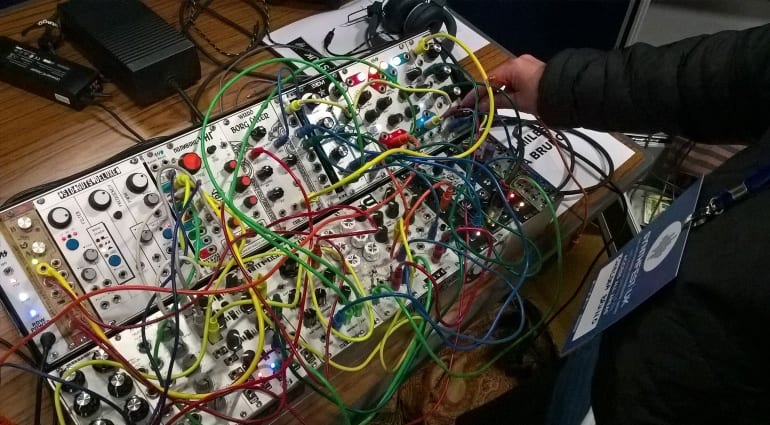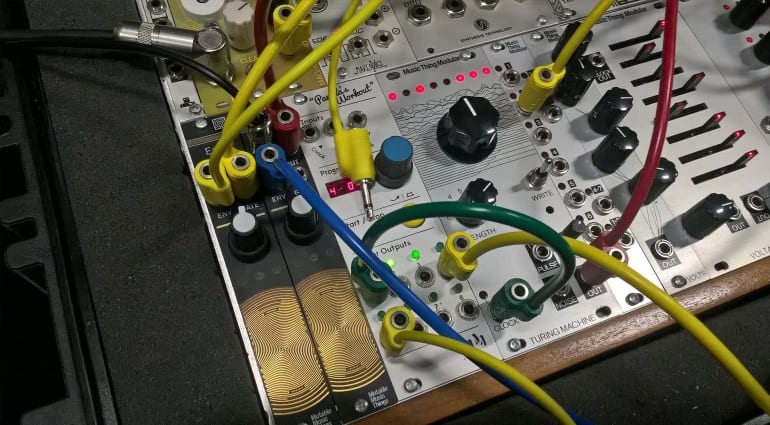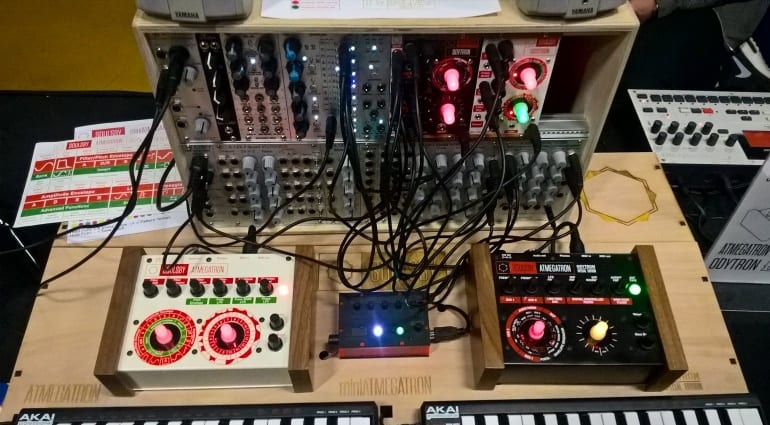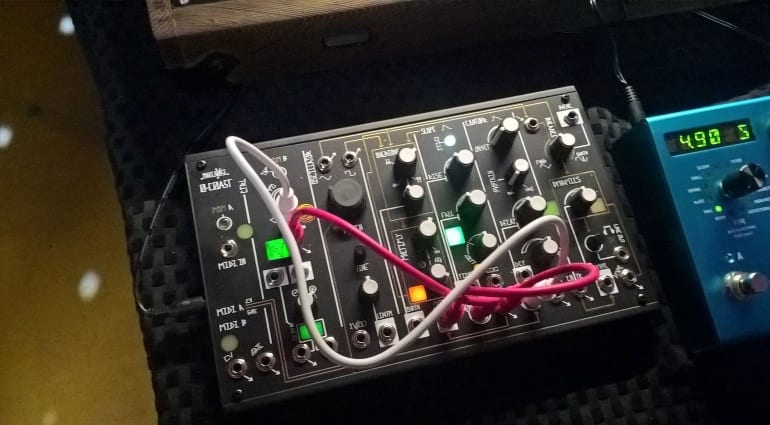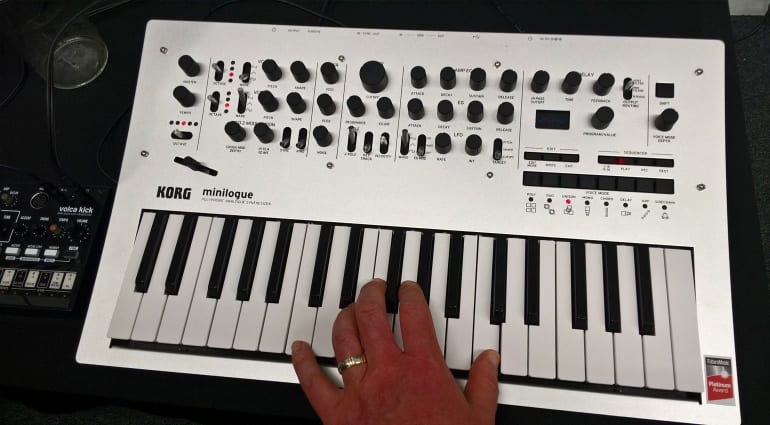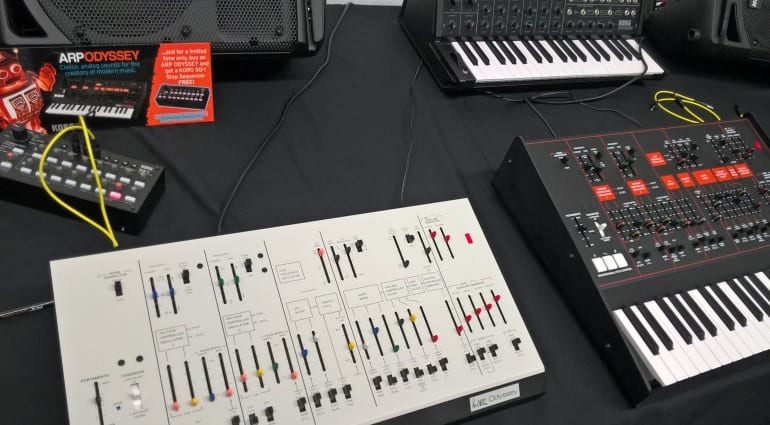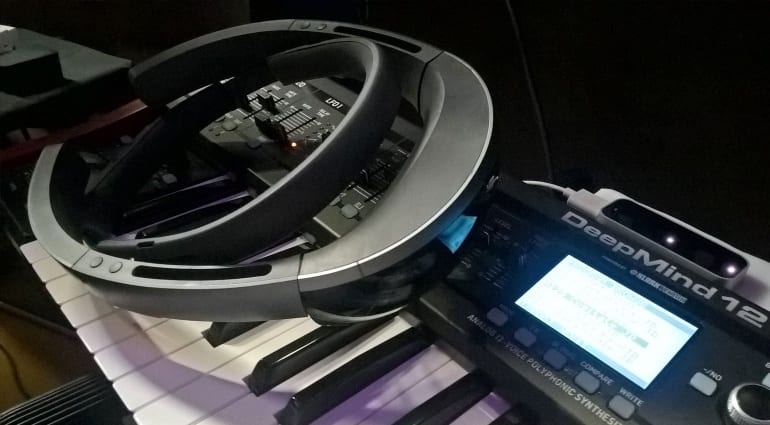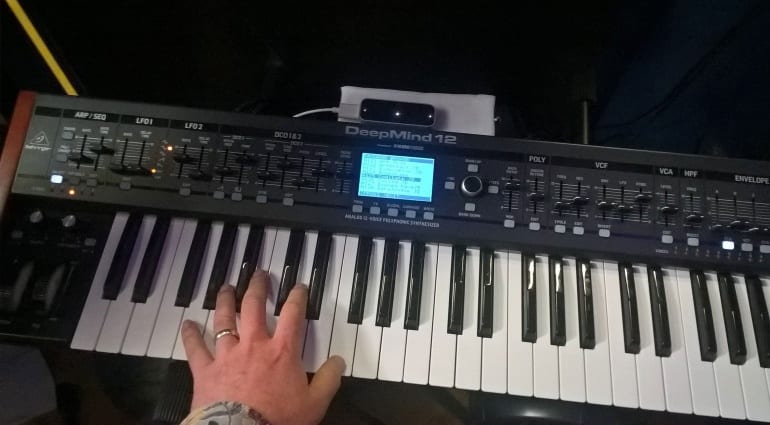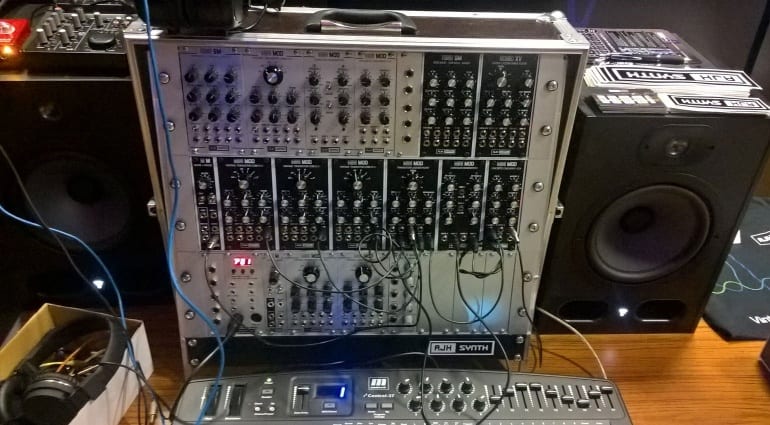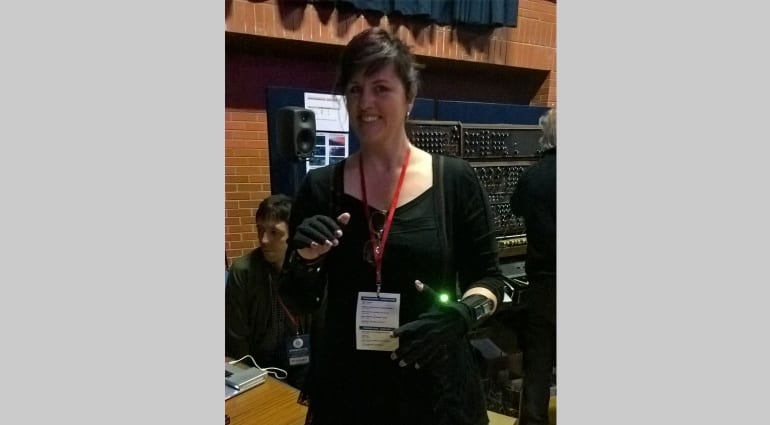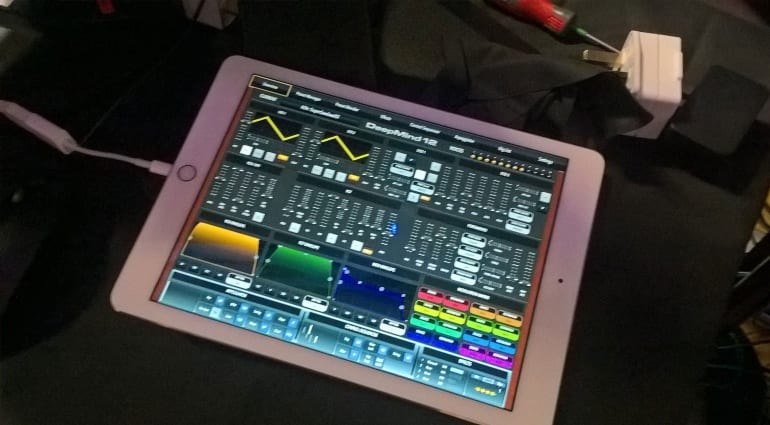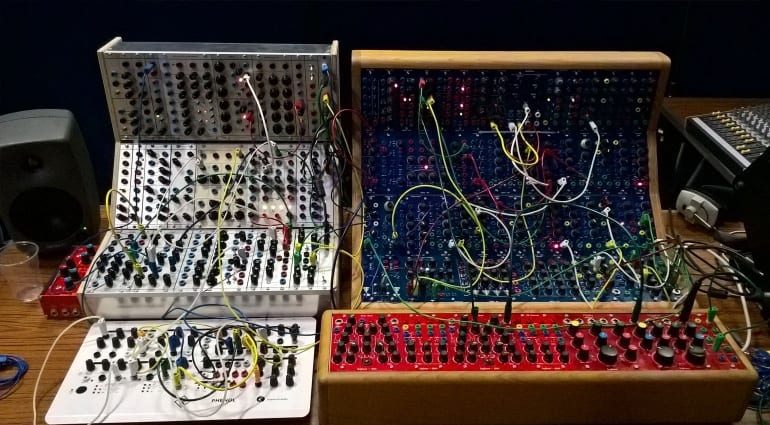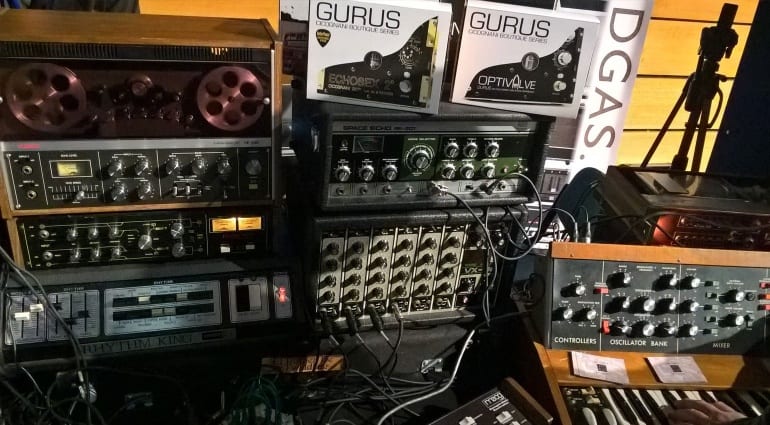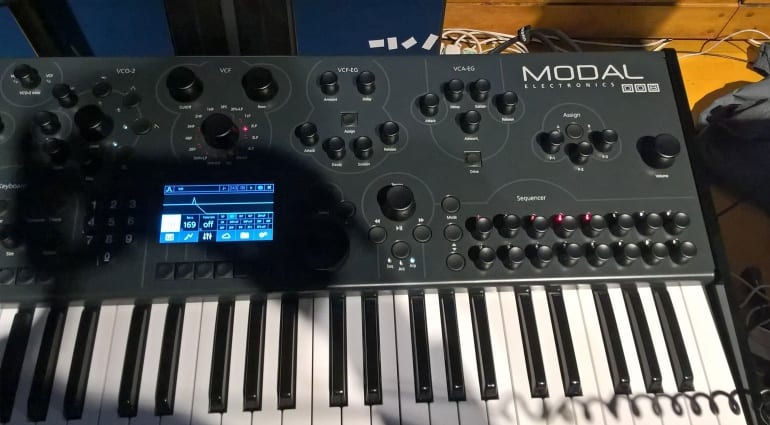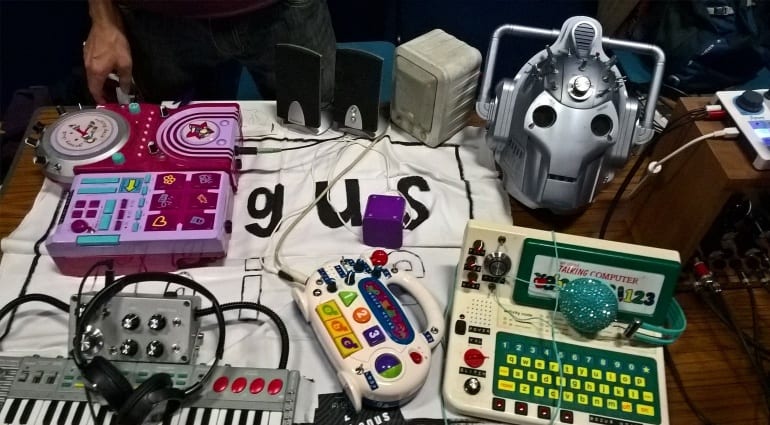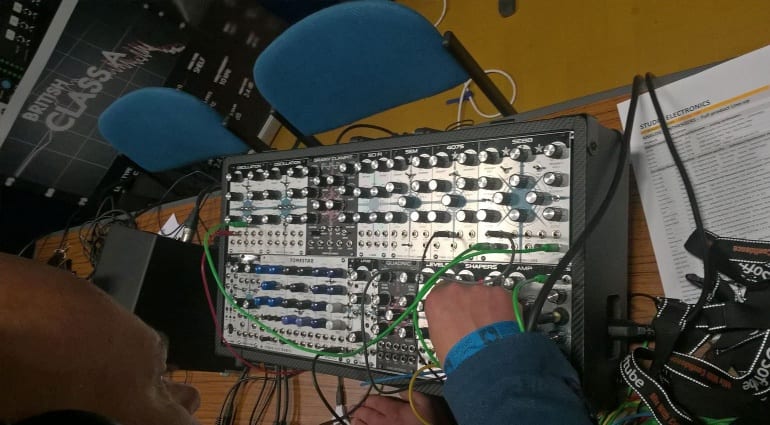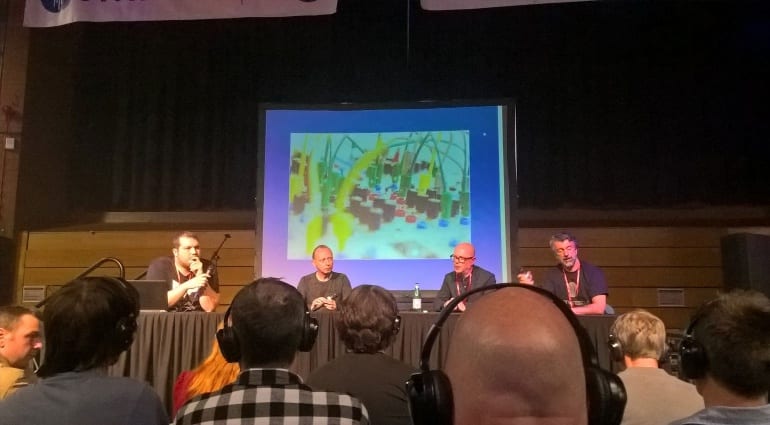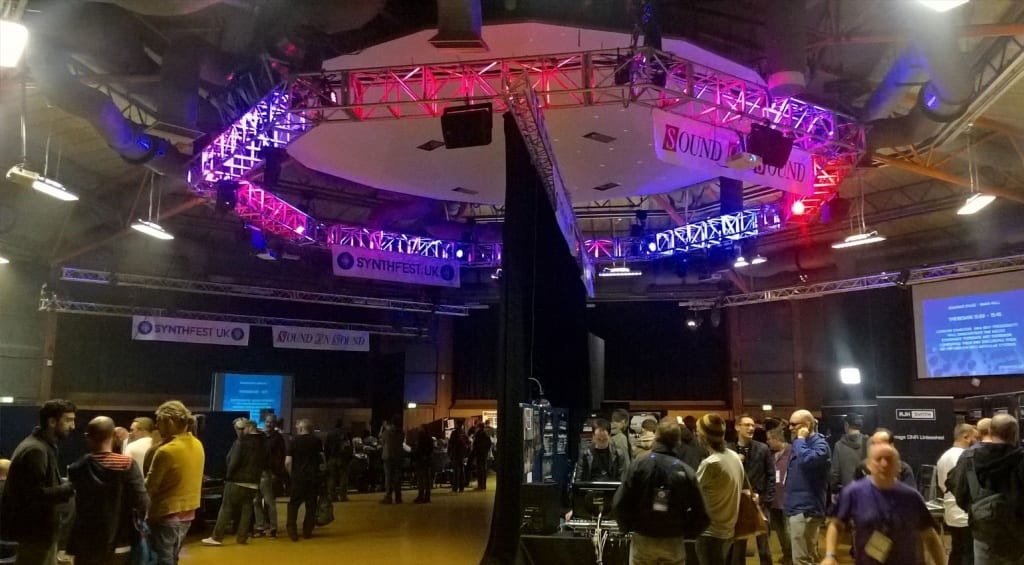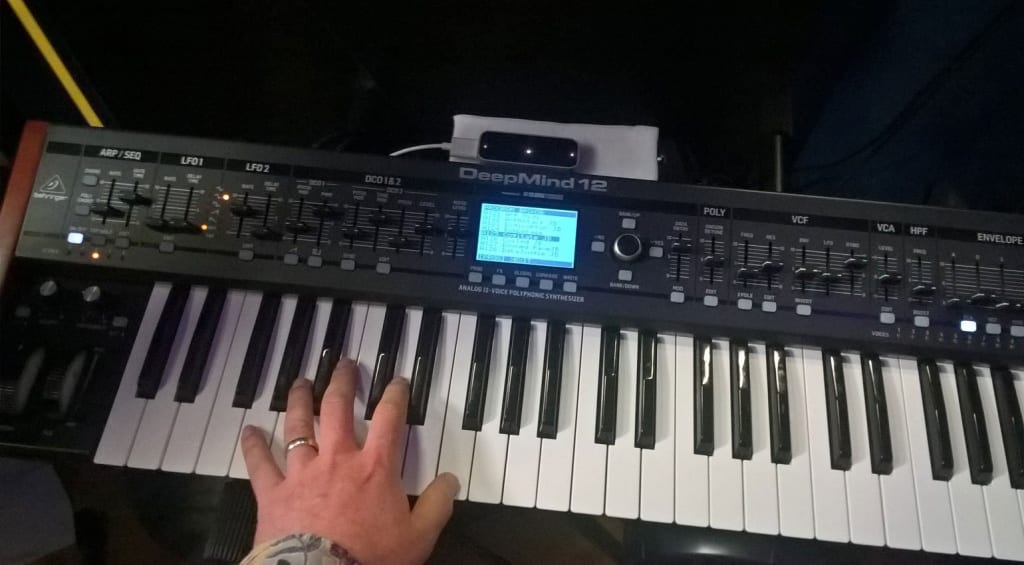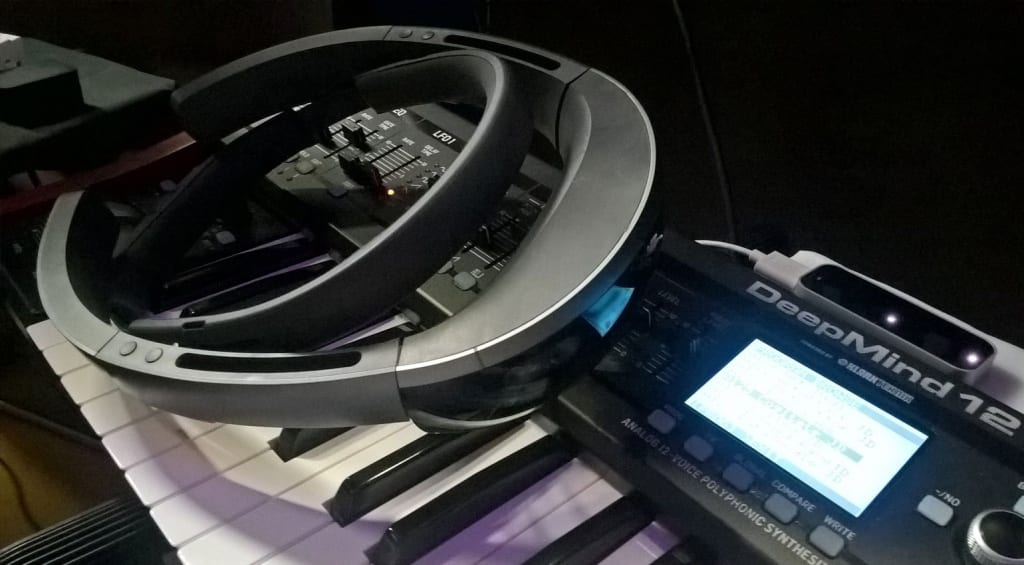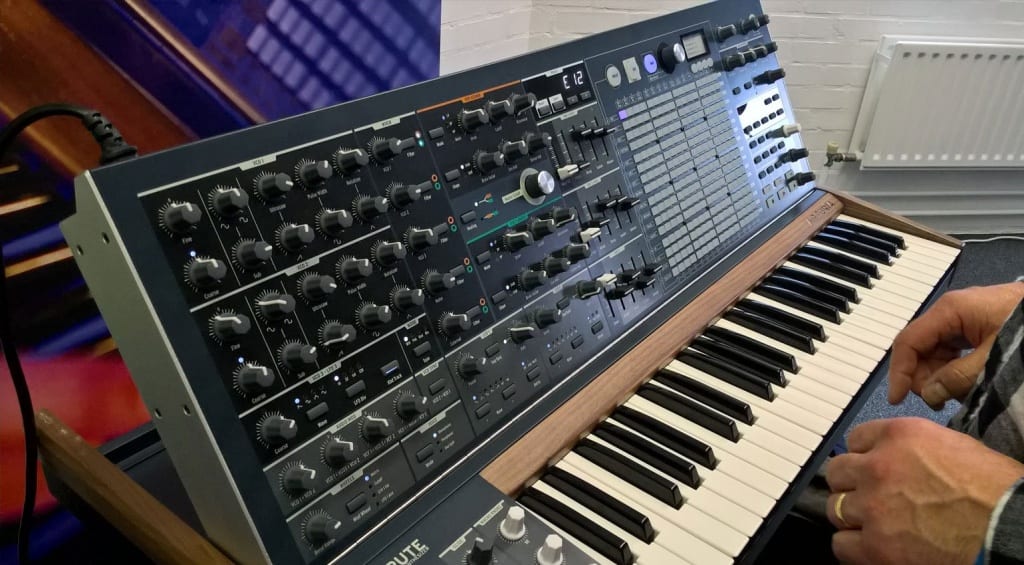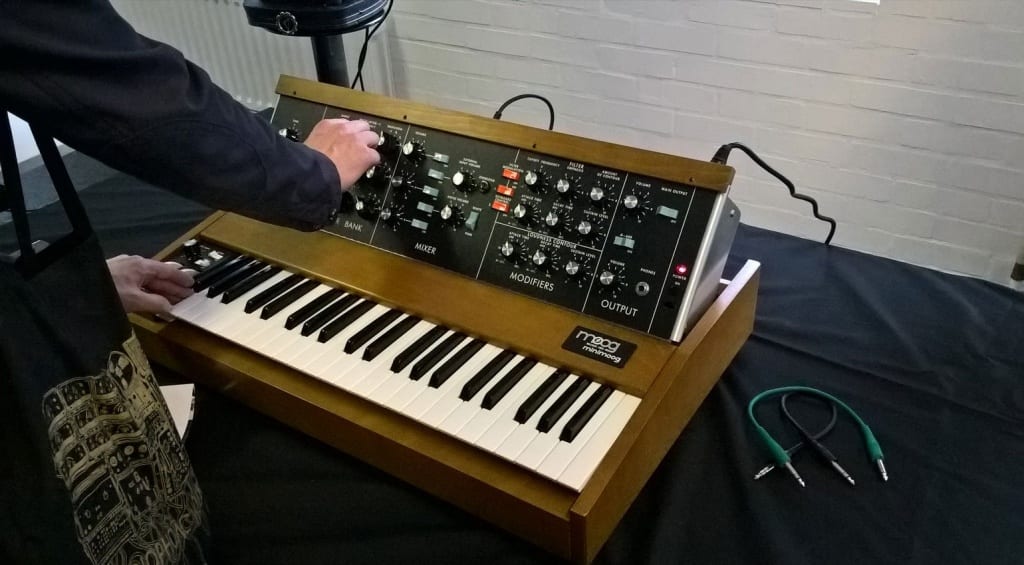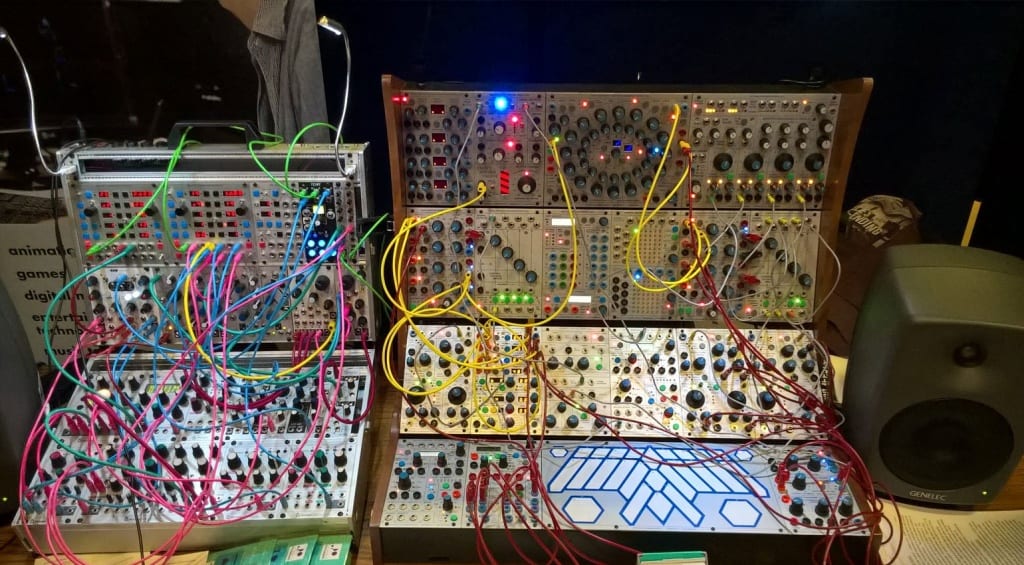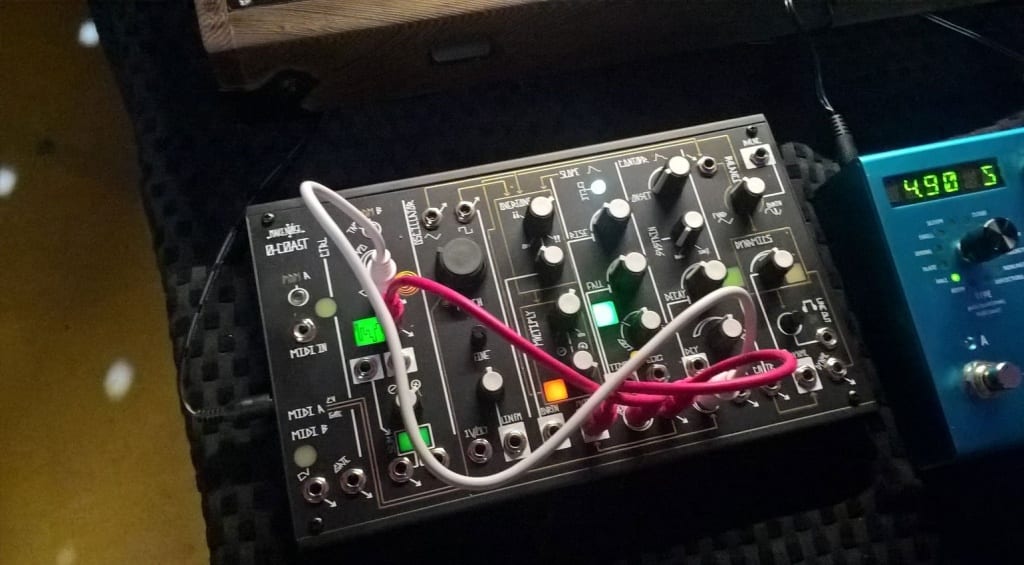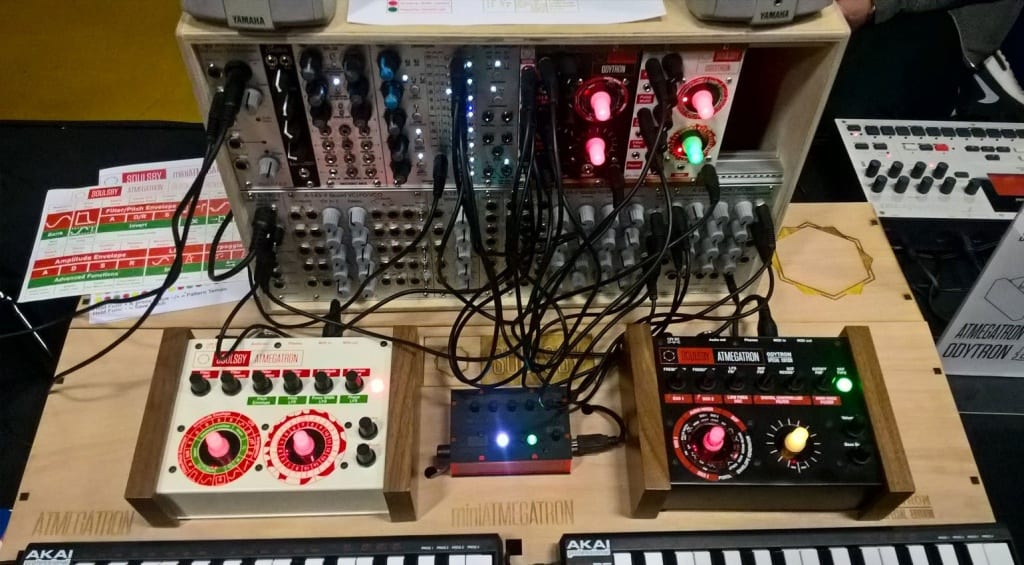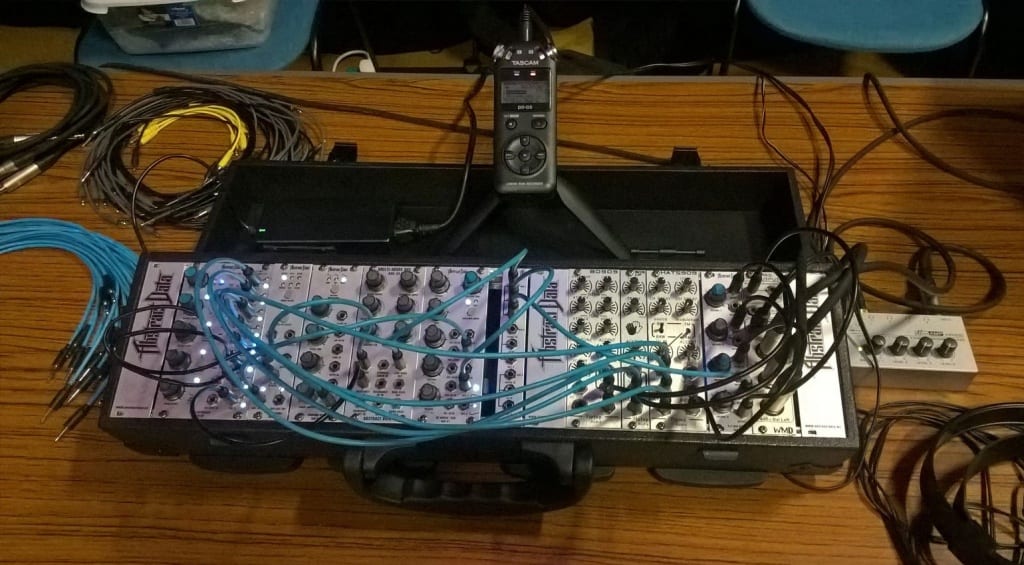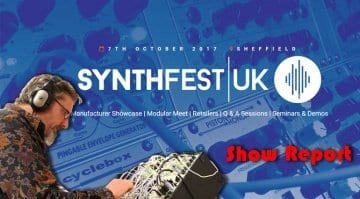SynthFest UK 2016: Show Report
Where I get completely bitten by the modular bug
On Saturday the 1st October the Synthfest came to Sheffield. Curated by Sound On Sound magazine it brought together synthesizer manufacturers, enthusiasts and explorers of electronically generated sound. Along with the big manufacturers there were plenty of independent modular makers, individuals showing off their rigs, and a nice program of seminars. I was there, I took it all in and here’s my report on a fabulous day of knob twiddling.
Getting my SynthFest bearings
The SynthFest was held in the Octagon at Sheffield University. It consisted of a main hall that housed the independent modular makers, and the “Modular Meet” individuals along with some retailers and distributors. Downstairs hosted the big guns – Korg and Yamaha had a room each and Source Distribution who do Moog and Arturia shared another. There were also two lecture spaces, one downstairs and one up in the main hall.
It was not a vast space and, sadly, it was far from crowded. But this meant that there was every opportunity to play on everything! That is surely the point of the exercise.
Traditional Synthesizer or Modular
Before I go into what was on display I wanted to share some thoughts on the overwhelming sense I got from the show. It feels like we’re in a space of massive transformation. The role of the traditional, big brand synthesizer has been slowly and inevitably undermined by the arrival of independent modular. What was once a fringe activity of DIY electronic nerds has now captured everyone’s imagination. It has this ability to democratise synthesis. You don’t need Korg or Roland to sell you an all-singing-all-dancing synthesizer anymore, you can design and build your own. That feels completely possible now – and it’s a very interesting shift. That feeling informed my approach and attitude to what I found and honestly, upstairs was far more interesting than downstairs.
Let’s start with the key bits of gear that everyone wants to see.
Behringer DeepMind 12
Of course the now legendary DeepMind 12 was there. In fact there were two, together with a whole gaggle of guys from Midas. It was really interesting talking to them. The synth itself was more petite than I’d imagined, not very deep in size. The layout was Juno-esque and easy to navigate. At a basic level you could set an arpeggiator going, fiddle with the filter and LFO and have a good old synthy time. It sounded great, enjoyable, there’s nothing not to like in terms of being a traditional synthesizer. However, there was a lot of stuff going on in the screen. Each section of the synth had an Edit button which then took you to deeper places on that screen. Things like LFO type and destinations, extra parameters, the effects were only accessible here. On a normal day with normal synths that would be completely fine. Surrounded by all this modular it felt rather fussy and weirdly dated.
Now, what is interesting with the DeepMind 12 is their self-awareness. I think they can feel that people are being turned off by the traditional approach and so, through the use of the digital brain residing inside the analogue signal path, they’ve brought in some interesting ideas with their iPad app. It’s an editor, which is fine, nothing new there. You can edit the effects in a lovely graphical way and get access to other parameters – all very nice. But they’ve also built in a performance mode where you can morph between 4 different presets. They’ve developed a preset manager that lets you build like a gig list so you can quickly access the sounds you need when performing live. They are continuing to evolve both the app and the internal software to meet the needs of the community. And it’s this communication via social media that has shaped this synth into being much more than just another synth.
At the moment they are working on a Microsoft HoloLens interface. It’s at early stages of dabbling with ideas of laser harps and interactive triggering but they’d brought it along to see if they can find out what ideas people might have about it. The Midas guys are buzzing with enthusiasm, excited about making this an awesome synth and I think that could carry them a long way.
They told me it will be out by Christmas and cost under $1000.
Arturia MatrixBrute
I thought this would be a lot more interesting. The interface is a bit boggling to be honest and I still find the actual matrix rather ugly. I was listening-in to a guy playing it and he was bashing buttons and turning knobs, trying and mostly failing to get some sounds out of it. When I got my go I didn’t fair much better until I discovered how to change presets. Then we were off! Yeah, it had some mojo going on. The mixer section seemed to be very important and you had to keep an eye on what was on or off as you went through the sounds. The matrix was a bit unfathomable for the short amount of time I was playing with it. Hitting the “SEQ” button didn’t seem to produce any fruit until I hit “record” and played a few notes. Now that I finally had something running I could play with the knobs.
The knobs seem to be the same as on their other synths. The big master cut-off was very nice. It sounded OK in a noisy show environment. The knobs are obvious and intuitive but it all falls down when you select another preset. This is an underlying theme of the traditional synth – it’s both why we love digital technology and why the preset-less modular is pulling us away. Hit another preset and the knobs mean nothing, they say nothing and you’re left scrambling around trying to make sense of things.
Korg
They had a room all to themselves with a keyboard Odyssey and two desktops, a Minilogue and a table full of Volcas. The Arp was complicated and frustrating. I could get sound out, mostly, although I was not always sure why. It didn’t seem to do what I asked it to. Lots of things didn’t appear to make any difference. Again the mixer section was key but… I dunno I guess it takes time to suss out and maybe it’s an indication of my ineptness rather than the Arp being difficult. I tried to deliberately build a sound starting with every slider down. That was a lot more fun but I still didn’t feel like I was in control. It certainly had a “sound” though. The unit themselves were huge – why do they have to be so big? Physically they seem clunky and a bit empty.
The Minilogue also seems too big for itself. There’s a lot of blank space and the slight curve on the body is just a bit odd. This worked a lot more like I expected it to. I was able to create and destroy sounds with abandon. Everything did what I thought it should. The layout was simple, easy to navigate and that little display is simply a beautiful thing. Unfortunately the outputs were wired to the same speakers as the Volcas that were sitting alongside so I couldn’t really get in touch with the finesse of the sound. The slim keyboard wasn’t great and of course it suffers from the same preset-kills-knob-position issue. I’d like to see a smaller desktop version, something closer to the size of a Moog Mother-32. I’d also like to spend more time with it.
Moog
The new MiniMoog Model D was there – and there was an original upstairs on the Sound Gas vintage stall. The Moog stuff is great but actually they seemed a bit sort of dated which is really weird to say because obviously the Model D is a vintage classic. I think perhaps what I mean is that the form factor of this huge wooden instrument seems more like a piece of furniture than a hard working synth.
I was playing with the Sub 37 when I had a bit of a revelation about the whole preset and knobs thing. With preset free synths like the Model D and the Mother-32 you can look at the controls and have a fair idea about what it’s going to sound like. As soon as you change a preset on something like the Sub 37 that knowledge has gone. And although it still sounds fabulous I’m having to go through the knobs to work out what’s controlling the sound. This is obvious stuff – I’ve not made a massive discovery or anything, I was simply struck by how this informs on the rise of modular.
Yamaha
I have no idea why Yamaha were there. They were showing off some enormous Motif monster (I think it’s called a Montage). It filled the room with all the automated rhythms and processed washes of synthetic sounds pretending to be real sounds of multi-timbral workstation mush. For me it represented everything we are trying to move away from in the pursuit of post-modern synthesis. Horrible. They did have their “reface” keyboards which is a fair attempt at re-capturing something of the music technology zeitgeist, but they are rather dull. Come on Yamaha there must be something stirring in those genius minds of yours, some nagging thought telling you that you are in danger of missing the boat and becoming irrelevant or at best another Casio.
I would have taken a photo but I really couldn’t bothered. Roland, where were you?
Modular
Where to begin with this stuff? In overhearing conversations around the stalls this was the most common question. It’s a tough one to answer and most responses were terribly vague. No one really knows how they got there – it’s like this massive array of modules just sort of crept up on them. I will be putting my thoughts together on this in another article but for the moment I just want to highlight some of what I saw at the show. And I apologise if I get any names wrong or miss someone out – there was lots of it! Check out the gallery above for more images.
Buchla – Portsmouth University
I am fascinated by the Buchla approach to modular and this awesome system was being demoed by a couple of students who couldn’t quite believe their luck. The controller at the bottom is very interesting. I like how it’s designed to work with the shape of your hands and the fall of your fingers rather than forcing us into that square and regimented fader paradigm.
Dreadbox
They do great modules, but the most fun was to be had on the Erebus. This is partly because personally I’m also in transition – I am only semi-modular and so I appreciate the ease with which a semi-modular box makes noises. Run a sequencer in and it’s instantly pleasing. The fun factor with the Erebus comes in the form of the echo – every synth should have one. I almost had to buy one but that of course raises that classic entry into modular quandary – why would I get a semi-modular box if I’m ultimately going to go full modular? But it’s fun and it works and…. it’s really good fun. It was more fun than any of the big brand synths I tried.
0-Coast
Talking about fun, the other source of it was the Make Noise 0-Coast semi modular box. Just like the Erebus it’s the perfect way of playing with modular sound in an easy to access format. The 0-Coast is quite different in it’s approach in that it adds tone and harmonics to the oscillator rather than removing them with a filter. The resultant sound stands out from most of the beeps around it and it’s instantly enjoyable to play with. I spoke to Mike at Red Dog Music who are probably the first high-street music retailer to grapple properly with modular. He said that they can’t keep the 0-Coast in stock – they fly out the door as soon as they arrive. Again it’s a quandary because it doesn’t fit in a Eurorack either – maybe it would be more interesting to build a similar unit in Make Noise modules.
Soulsby
These are little boxes that produce an amazing array of 8 bit noises. They look fabulous, completely different to anything else out there and the sound is classic computer games and chip-tune. They are releasing Eurorack versions, they had the prototypes on display.
It brought to light another interesting factor in today’s modular – it’s not all about analogue. What seems to be important is hands-on control and the ability to patch. What lies behind the panel, whether analogue or digital, is completely irrelevant. That’s a major factor in making modular different today than it was in the past. There’s none of the snobbery – it’s all about cool stuff that works in the modular paradigm. Soulsby hope to have the modular version out by Christmas.
Abstract Data
A great example of a small independent developer of modules. Lined up in a neat rack bleeping and banging away. Justin Owen, the owner, was there with his gear completely happy to talk about what he’s doing. Another one of the attractions of modular is that you get to talk to the person who designed, built and produces the modules – there’s no sales rep in the way (usually) or a slightly overwhelmed music shop assistant working on commission. You get straight to the source.
Thonk
Purveyors of the finest DIY module kits. A cheaper way into modular is to built the little modules yourself. They said that all you need is the ability to use a soldering iron – or at least the willingness to learn to use one. Going beyond building your own synth out of modules this can give immense satisfaction in building the module itself. They made it sound really easy – they also produce very detailed instructions and will talk you through it over the phone if necessary. I love this connected and engaged attitude that I found all over the show. All the time the little modular imp on my shoulder whispers – “go on, give it a go.”
Modular Meet
The other side of SynthFest was the opportunity to meet modular enthusiasts – people with their own system to show. One such person was Chelsea Bruno who was one of the very few women behind a stall. She had this wonderfully eclectic collection of modules patched together in a two tier Euroack case. The whole time we chatted her fingers danced over the modules, adjusting, re-patching, modulating, like an artist sculpting an ever-evolving piece of clay. It was magical to witness. There were a handful of other exhibitors but not as many as I imagined. I kind of wish they did more to interact with each other, or were given the opportunity to perform. There was no performance space – seminars yes, but actual music making was less evident.
The Rest
There were a lot more exhibitors and companies present showing all sorts of exciting things. Check out the image gallery above for just a sample.
Seminars
There was a program of seminars hosted by Sound On Sound magazine and from I could see they were all well attended. It was quite a mix of concepts. There was a seminar on coding in live performance, which means absolutely nothing to me. Ableton Live and working with Max For Live were presented along with the Mi-Mu synth controller gloves. There was a talk on early British electronic music and a history of the Ones Martenot keyboard. Marc Doty from Moog talked about synthesizer history and Gordon Charlton demoed the Theremin. Divkid Ben Wilson chaired a session of how to get started with Modular and the day ended with a VIP roundtable discussion. I think these sorts of things are a vital part of any music gear show. I know we can learn everything we ever need to know from YouTube but getting the opportunity to hear people talk about our interests in an intelligent and interactive way is a wonderful thing.
Diversity
Sheffield is a very multi-cultural town which was very much reflected in the members of staff and security. Not so much in the attendees who were overwhelmingly white, male and over 40. There was definitely a percentage of woman present who were there for themselves rather than just being partners of the aforementioned male dragged along for the day, but the percentage was small. Ethnic diversity was also small. Modular synthesis does have the air of an middle aged man’s hobby about it – a bit like Hornby railways or building steam engines. Hopefully this is only because modular hasn’t been long out of the shed and perhaps as it approaches mainstream it will break out of this stereotype. It’s not a cheap hobby either which might explain the slightly older age group. People with both money and time tend to be those whose children have finally grown up and left home.
The two women exhibitors I spoke to had far more than a casual interest in synthesizers. Chelsea, who I mentioned above, had finished a Masters in music technology and was looking to do a PhD in synthesis. Dr Kelly Snook, music producer and technologist from Brighton University, was demonstrating the mi.mu Gloves of which she is one of the creators, and a Theremin. She was also hosting one of the seminars. Anais Neon from Vile Electrodes was also present. These women perfectly shatter any concepts of synthesis being a male domain.
Summing Up
We live in interesting synthesised times. No one could have predicted that modular would risen so quickly and so diversely over the last year or so. It’s a community driven thing. Social media lets people share their setups, drop videos of latest patches, and wallow in each others inspiring beeping noises and flashing lights. The constant stream of newbie questions doesn’t seem to phase the members of forums or facebook groups. There’s this sense that this is our world of modular, it’s awesome and you are completely welcome. When the old guard of synthesis like Korg and Roland seem so unapproachable the community spirit of modular is a huge breath of fresh air.
Modular also welcomes the introvert into a creative space. There’s no sense of having to perform like a lead guitarist – to be all preening and posing. Instead you work the knobs, you craft sound and let the results speak for themselves.
I don’t think the traditional synth is dead, far from it, and there’s no need for one thing to replace another. But the industry is changing and it requires a different approach. Roland have shown a lot of wisdom in their recent Boutique and ACB mock-analogue synths. Korg have also tapped into what people are looking for. But perhaps it’s Behringer that are showing a way forward by moving vintage ideas forward into new technologies.
However, modular has it’s own thing going on. It’s exciting because it’s hard and takes some thought and with that comes the sort of reward you don’t get from a computer full of 10,000 instantly accessible, tagable, searchable, curated sounds. The restrictive nature of having a single voice and seeing what you can do with it is immensely freeing. I am so tired of stepping through presets and modular offers a remedy to that. Now, how on earth do I begin?
I hope events like SynthFest continue to grow and evolve. Music shops do have a lot of this gear on demo but there’s something about bringing people together to share in a passion. I’m looking forward to the next modular meet – wherever that may be.
More details on the SynthFest can be found here.

